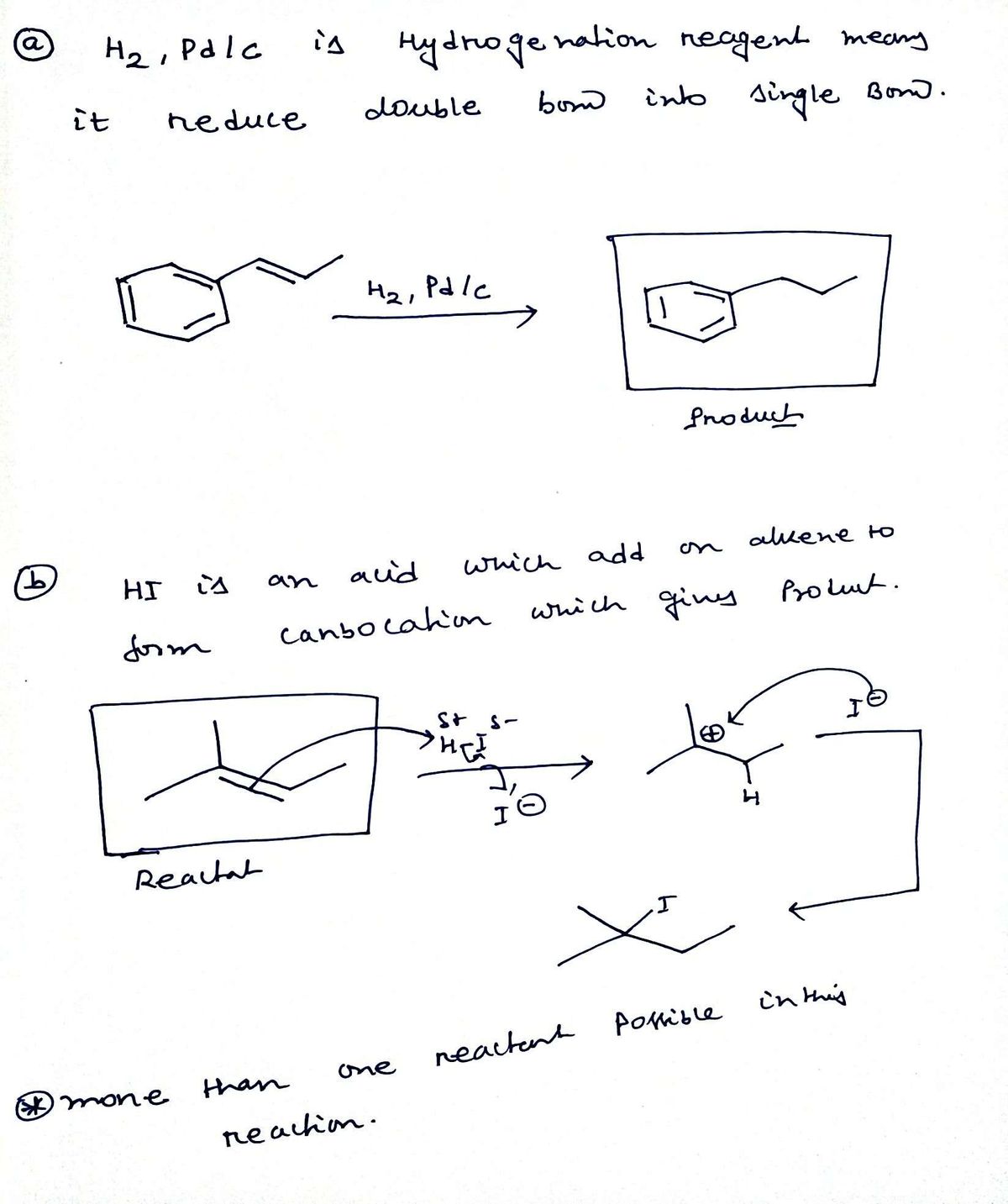Chemistry
10th Edition
ISBN:9781305957404
Author:Steven S. Zumdahl, Susan A. Zumdahl, Donald J. DeCoste
Publisher:Steven S. Zumdahl, Susan A. Zumdahl, Donald J. DeCoste
Chapter1: Chemical Foundations
Section: Chapter Questions
Problem 1RQ: Define and explain the differences between the following terms. a. law and theory b. theory and...
Related questions
Question

Transcribed Image Text:**Instructions:**
Please fill in the blank for the following four questions. Attach your answer as an attachment at the bottom.
---
**Question a:**
- **Chemical Reaction:** The given structure is an alkene attached to a benzene ring.
- **Reagents:** \( \text{H}_2, \text{Pd/C} \)
- **Task:** Identify the product of this hydrogenation reaction. The reaction involves the addition of hydrogen across the double bond in the presence of a palladium/carbon catalyst.
**Diagram:** To the right, there is a blank box where the product structure should be drawn.
---
**Question b:**
- **Chemical Structure:** There is an empty box where the initial reactant should be drawn.
- **Reagents:** HI (Hydroiodic Acid)
- **Product:** The structure shown is an alkyl iodide, featuring an iodine atom attached to a branched alkane.
**Diagram:** To the right of the empty box, the structure of an iodide compound is given, indicating the product after the reaction with HI.
---
**Note:** There are more questions further down, suggesting the presence of additional reactions involving catalysts, but only parts (a) and (b) are shown in the image.

Transcribed Image Text:### Organic Chemistry Reactions
This image presents two organic chemistry reactions:
#### Reaction c:
- **Starting Material**: A linear alkyne with six carbon atoms.
- **Reagents**: \( \text{H}_2 \), Lindlar Catalyst
- **Description**: This reaction involves the partial hydrogenation of an alkyne to an alkene. The use of a Lindlar catalyst typically results in a cis-alkene.
#### Reaction d:
- **Starting Material**: A cyclopentyl alkyne.
- **Reagents**: \( \text{H}_2\text{SO}_4 \), \( \text{HgSO}_4 \), \( \text{H}_2\text{O} \)
- **Description**: This reaction involves the hydration of an alkyne to form a ketone. The reagents suggest an oxymercuration-demercuration process, typically converting the alkyne into a ketone through the Markovnikov addition of water.
Expert Solution
Step 1

Step by step
Solved in 2 steps with 2 images

Knowledge Booster
Learn more about
Need a deep-dive on the concept behind this application? Look no further. Learn more about this topic, chemistry and related others by exploring similar questions and additional content below.Recommended textbooks for you

Chemistry
Chemistry
ISBN:
9781305957404
Author:
Steven S. Zumdahl, Susan A. Zumdahl, Donald J. DeCoste
Publisher:
Cengage Learning

Chemistry
Chemistry
ISBN:
9781259911156
Author:
Raymond Chang Dr., Jason Overby Professor
Publisher:
McGraw-Hill Education

Principles of Instrumental Analysis
Chemistry
ISBN:
9781305577213
Author:
Douglas A. Skoog, F. James Holler, Stanley R. Crouch
Publisher:
Cengage Learning

Chemistry
Chemistry
ISBN:
9781305957404
Author:
Steven S. Zumdahl, Susan A. Zumdahl, Donald J. DeCoste
Publisher:
Cengage Learning

Chemistry
Chemistry
ISBN:
9781259911156
Author:
Raymond Chang Dr., Jason Overby Professor
Publisher:
McGraw-Hill Education

Principles of Instrumental Analysis
Chemistry
ISBN:
9781305577213
Author:
Douglas A. Skoog, F. James Holler, Stanley R. Crouch
Publisher:
Cengage Learning

Organic Chemistry
Chemistry
ISBN:
9780078021558
Author:
Janice Gorzynski Smith Dr.
Publisher:
McGraw-Hill Education

Chemistry: Principles and Reactions
Chemistry
ISBN:
9781305079373
Author:
William L. Masterton, Cecile N. Hurley
Publisher:
Cengage Learning

Elementary Principles of Chemical Processes, Bind…
Chemistry
ISBN:
9781118431221
Author:
Richard M. Felder, Ronald W. Rousseau, Lisa G. Bullard
Publisher:
WILEY